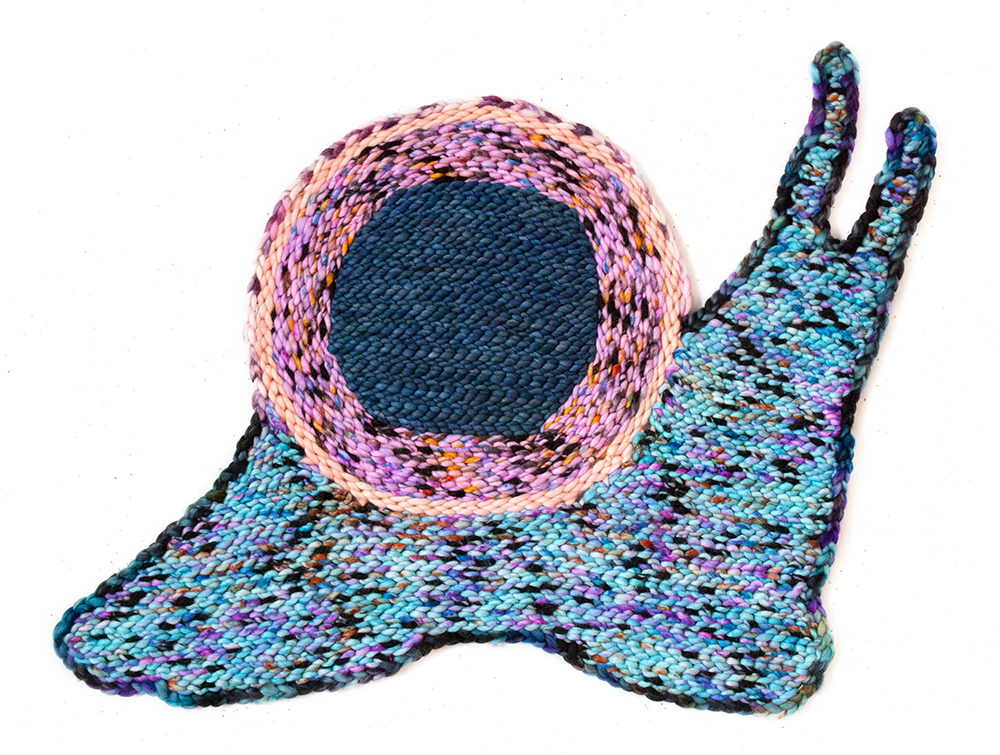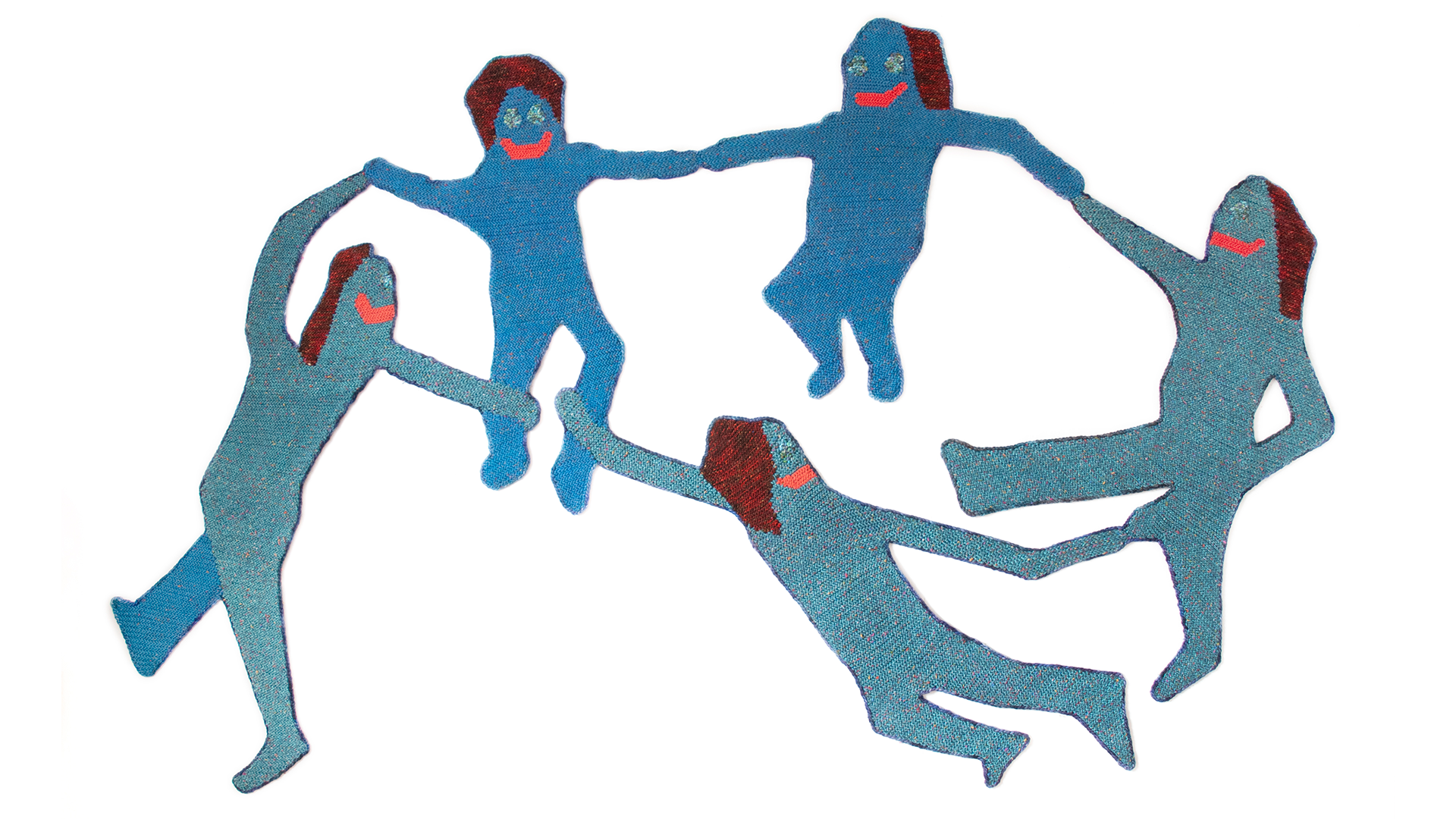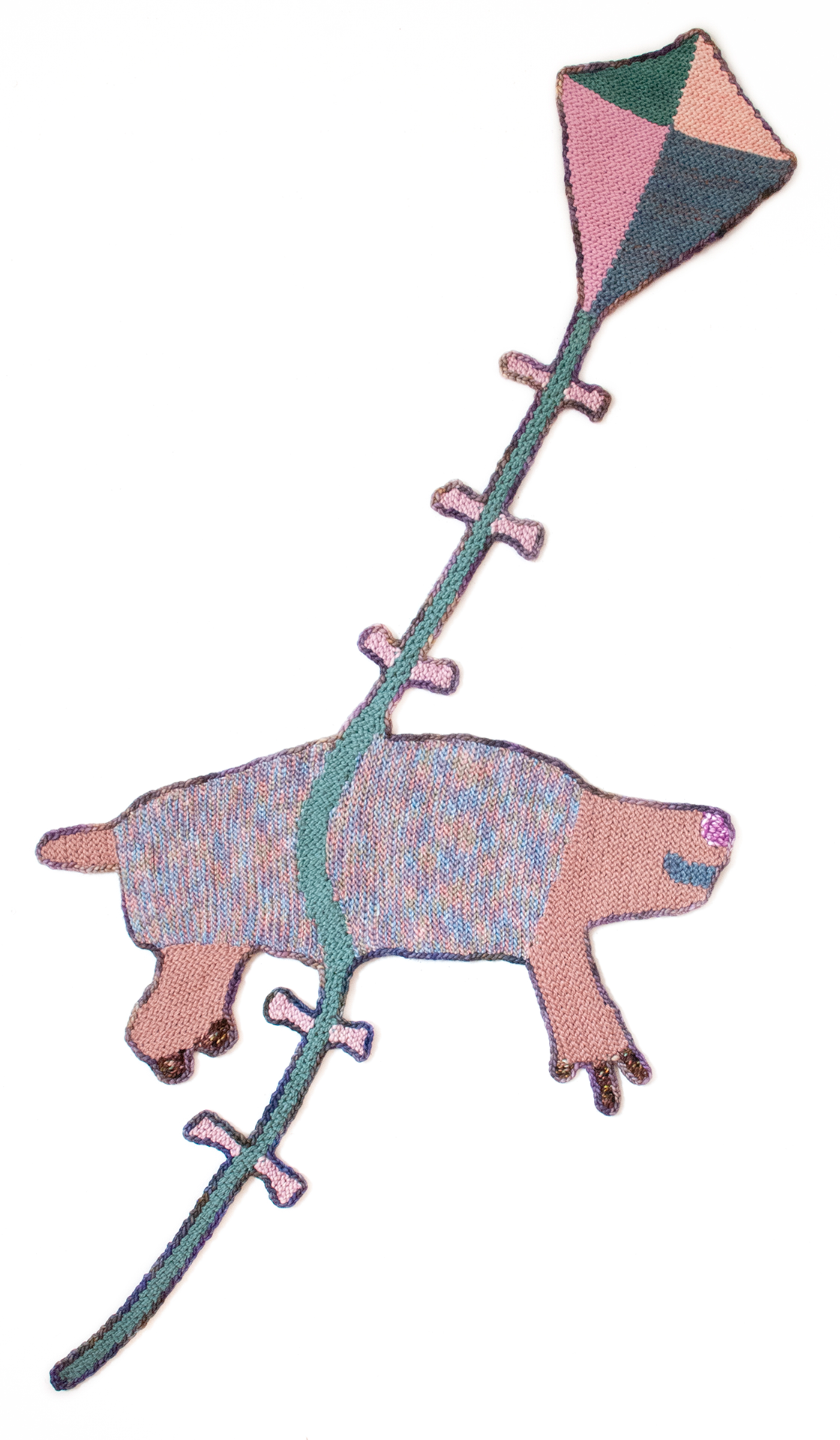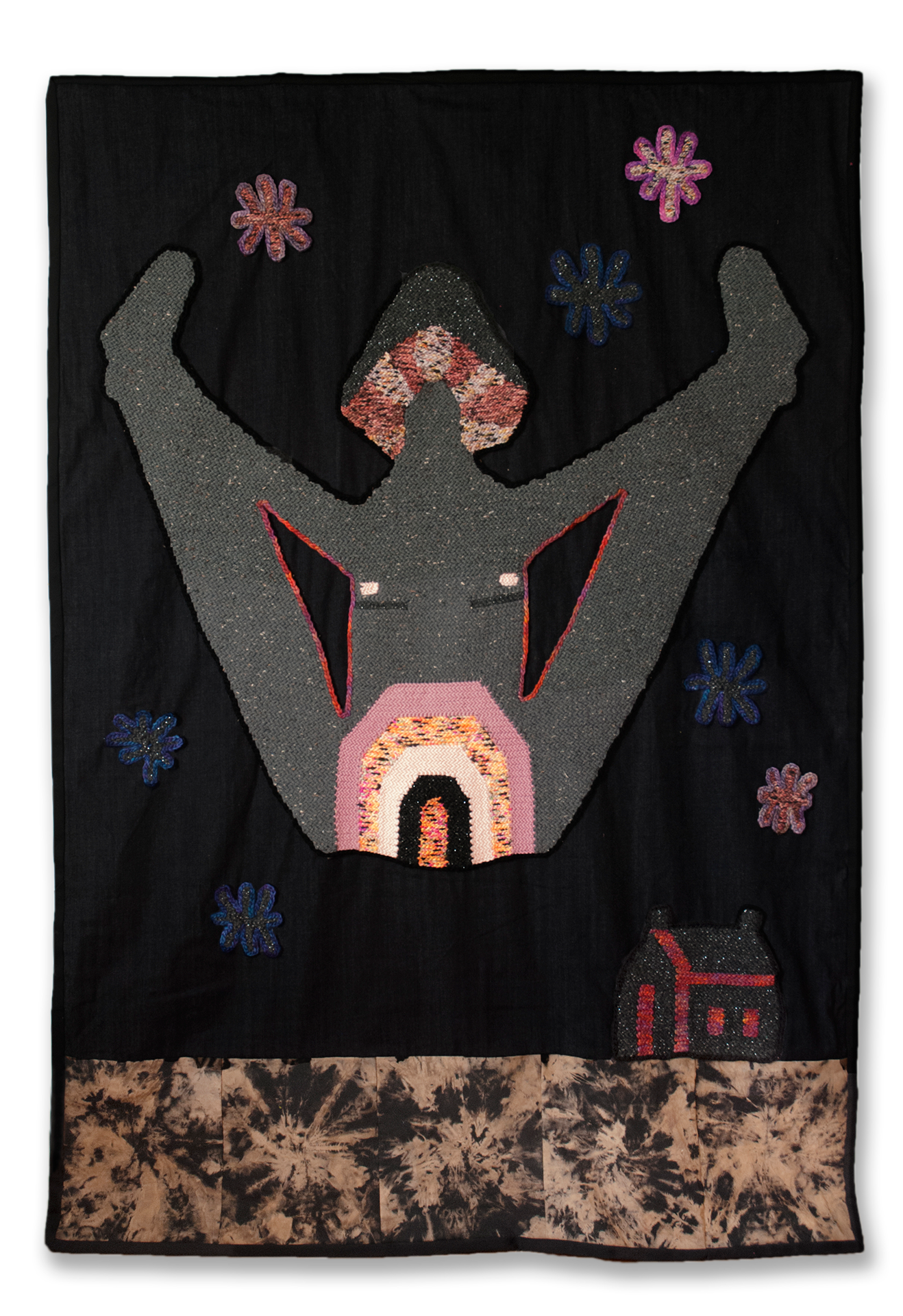
The Cosmic Egg (2023), hand crocheted assorted fibers, 19" x 21". image / provided

Lesbian Lovers, Mothers and Sisters Past, Present, and Future (2023), hand crocheted assorted fibers, 82" x 123". image / provided
To step into recent installations created by Wells Chandler is to find oneself surrounded by an entire world of vibrant characters crocheted by the artist, their energy animating the space in wonderful ways. While the task of conceiving and executing such large-scale works by hand is remarkable, his practice is mainly rooted in the everyday tools available at American craft stores. What begins as black magic marker drawings on computer paper evolves through skeins of brightly colored yarn into a welcoming and all-encompassing experience. Chandler takes similar care with his approach to pedagogy, fostering an environment that allows students to be open and vulnerable together.
In addition to his work throughout the semester with undergraduate and graduate students, Chandler will discuss the trajectory of his work exploring ecology, community, gender, and queer iconography through the mediums of crochet, embroidery, drawing, and cake during an artist talk on Thursday, March 23, at 5:15 p.m. in the Abby and Howard Milstein Auditorium. In advance of that event, he shared insights into his process and motivations.
When I started exploring your work, crafted out of so much amazing yarn, embroidery floss, fabric, and even decorative plastic trinkets and repurposed food items, I immediately wanted to invite you to go shopping at JOANN or Michaels. I wanted to see what attracted your eye or inspired you. This fantasy shopping trip aside, can you share a bit about how you came to invest in this particular media palette?
I will totally go shopping with you! I primarily source my materials from both of those stores, as well as a few specialty yarn shops. This sort of happened accidentally. When I was completing my undergraduate studies, I was not aware that there was a fine arts store in Dallas until the second semester of my senior year. Simultaneously across the country, craft was on its last legs and schools were removing any association to it. Feminist art and feminism was also super unpopular. I am an iconoclast and tend to embrace things that others reject and view dismissal as a potent site to dig in.
Making my own language from materials sourced from American craft stores became foundational to my studio practice in graduate school. Prior to honing in on yarn as a primary medium, I would go on vision quests at both Michaels and JOANN to make my work. Because I wear a vest and have an authoritative swagger to my gait, I am often mistaken as an employee at both stores. I enjoy this misidentification and take pleasure in talking with fellow crafters about their projects.

The Cosmic Egg (2023), hand crocheted assorted fibers, 19" x 21". image / provided
The brightly colored figures you've crafted have such a joyful, animated quality. Scrolling through the images of your recent installations, it felt as if you'd brought an entire world to life. Is this a world you're creating initially for yourself or for the viewer?
When I came out as transgender twelve years ago, I lost the support of my biological family. It was the greatest loss and pain that I have ever experienced. It felt like one hundred deaths. The figures that populate my crocheted installations are fierce and friendly guardians. They are talismans of protection and they remind me to seek out relationships that are joyful, celebratory, and loving. I guess I make my work for me first, but I hope it also helps people feel lighter as they scoot along on their own journey. My niece Lulu, who is now nine but was two at the time, really responded to the early crocheted works. I believe children are wise and plugged in because they have not yet been domesticated. I have made many works that are a tribute to her. Baby Lulu is my guide!
The sheer physical labor that must go into so many of your pieces, especially the large-scale crochet work, is stunning. What is your process for taking these from idea to plan to completion?
I draw almost every day. I draw with black magic marker on computer paper. Sometimes I draw in the morning when my mind is clear. Other times I draw in the evening when my mind is cluttered and full. I often get ideas for works when I am relaxed and walking in the woods. When I enter back into my apartment, I get the drawing down. I think in images first. I have stacks of these drawings on crappy computer paper. When I have a show, I ask for a floorplan and I select the drawings that feel most compelling together. I then start making things. I want the color to be relational and porously informed by its neighbor. I crochet everything myself and do not work with assistants. The entire work is the installation. I want the space to resonate like a Giotto. I want people to feel like they are inside of it and a part of it. I want people to forget they are separate.

Lady Bug Nut (2023), hand crocheted assorted fibers, 68" x 86". image / provided
While we were corresponding, you mentioned that, pedagogically, you are interested in countering public-facing social media culture and prioritizing intimacy and presence. What brought you to this perspective and how does this impact your teaching?
I’ve been teaching for over a decade. Currently, most of my students have anxiety disorders that I believe are a result of being on their phones and overloading their nervous systems with too much information. If someone is anxious or if someone is socioeconomically oppressed, experiencing micro or macro racism, sexism, transphobia, homophobia, or ableism, they may be in a traumatized state which makes being receptive to learning very difficult. Part of my pedagogical focus is to help students develop tools to navigate the sludge so they feel safe enough to open up and be vulnerable.
Like bell hooks, I believe education is emancipatory. School is a place where a person is able to question the programming they arrived with. I believe this process is hindered if we are performing persona for a public. I want us to take off our armor and be with each other. That feels like the first step toward achieving something real and meaningful together.

Do You Ever Feel Like a Plastic Bag? (2023), hand crocheted assorted fibers, 78" x 44". image / provided
As the Spring 2023 Teiger Mentor in the Arts, you're working closely with undergraduate and graduate students. What do you prioritize in these interactions and what do you take away from them?
I am trying to create a learning space that is foundational in love, generosity, openness and kindness. This requires deep listening and being present. Play is also important. I believe play is powerfully symbolic and ritualistic. I am also interested in sharing my community with students as an example of how to cultivate meaningful relationships. It is also my hope that they can connect with the artists I bring with me. As a result of our time together, I want students to feel more grounded in who they are and connected to what they are doing in the studio. I also hope they will choose to be ethical people with a focus on community as they enter our field.
It has been an incredibly positive experience getting to know the graduate students at Cornell and working with Leeza Meksin, whose work I have been following since 2007. It is an honor to be trusted with the responsibility of caring for our students and especially meaningful for me to work with someone who I deeply respect to deliver an enriching and supportive experience for the grads. I also feel indebted to the Fall 2023 Teiger Mentor and my friend, EJ Hauser, who suggested me for this position. I will be able to give a more accurate report as to what I expect to take away from the students when our time together has concluded.

Merry Roads (2023), hand crocheted applique on quilted and dyed denim, machine and hand sewn, 100" x 68". image / provided
Created with a gift from David Teiger '51, each semester the Teiger Mentor in the Arts Program invites a practicing artist to Cornell's Ithaca campus to share their experience and perspective through studio and seminar class visits, as well as individual critiques with M.F.A. students. Previous mentors have included current Visiting Critic in the Art Department Emilio Rojas, Emily Jacir, Miatta Kawinzi, and Candice Lin, offering undergraduate and graduate students enriching opportunities to make connections with and learn from a diverse range of leading contemporary working artists.